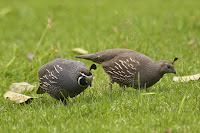CALIFORNIA QUAIL
CALIFORNIA QUAIL (Callipepla californica) (See images below)
DESCRIPTION: The California Quail male has a dark brown head with a curved black tuft of black feathers, which makes it easily identifiable. There are a white and a black superciliar stripes, and the throat is black and bordered by a fine white line. The nape is scaly brown and white. The breast is grey and the back and wings are brown. The under parts are scaly brown and light grey. The tail is brown, short and square. Legs are grey. Females are largely brown with part of the same plumage pattern as the male. They have a smaller head tuft. Juveniles have a shorter head tuft and look like females. The bird is around 10 inches (25 cm) long.
VOICE: https://www.xeno-canto.org/species/Callipepla-californica
NAME: The name ‘Quail’ is from old French ‘quaille’ and refers to the bird’s call. As for the Latin genus name ‘Callipepla’, it comes from Greek and means ‘beautifully dressed’ (no less!).
HABITAT: Dry shrubland, fields, forest edges. The California quail can be found in groups called ‘coveys’ along the roads as they forage on the ground.
DIET: Mainly made of seeds, but also insects (young especially), leaves and fruit.
NESTING: The nest is built on the ground and made of dry grass in a sheltered area. An average of twelve whitish eggs are laid. They hatch around the same time. The California quail is a species that practices ‘communal brooding’, where the chicks from different parents are raised by all those parents.
DISTRIBUTION: As the name implies, the California Quail is native to California and the West Coast of the United States. Some individuals are found in southern British Columbia. It is the State Bird of California. This quail has been introduced to different parts of the world (Australia and New Zealand for example) as a game bird. It has been introduced to Hawaii around 1850. It does not migrate.
CONSERVATION: The California quail is a popular game bird and is hunted legally. The numbers taken don’t seem to negatively impact its overall population, which appears stable.
NOTES: California quails enjoy taking dust baths in groups.
I observed a male perched on a fence post by the side of Saddle Road not far from Waimea on the Big Island, but it took off as soon as we slowed down to take a photo.
SIMILAR SPECIES: Gambel’s Quail, Mountain Quail
REFERENCES: https://en.wikipedia.org/wiki/California_quail
https://www.allaboutbirds.org/guide/California_Quail/id
https://www.audubon.org/field-guide/bird/california-quail
https://www.nationalgeographic.com/animals/birds/c/california-quail/
http://birdweb.org/birdweb/bird/california_quail
https://identify.whatbird.com/obj/90/_/California_Quail.aspx
http://nzbirdsonline.org.nz/?q=node/52
DESCRIPTION: The California Quail male has a dark brown head with a curved black tuft of black feathers, which makes it easily identifiable. There are a white and a black superciliar stripes, and the throat is black and bordered by a fine white line. The nape is scaly brown and white. The breast is grey and the back and wings are brown. The under parts are scaly brown and light grey. The tail is brown, short and square. Legs are grey. Females are largely brown with part of the same plumage pattern as the male. They have a smaller head tuft. Juveniles have a shorter head tuft and look like females. The bird is around 10 inches (25 cm) long.
VOICE: https://www.xeno-canto.org/species/Callipepla-californica
NAME: The name ‘Quail’ is from old French ‘quaille’ and refers to the bird’s call. As for the Latin genus name ‘Callipepla’, it comes from Greek and means ‘beautifully dressed’ (no less!).
HABITAT: Dry shrubland, fields, forest edges. The California quail can be found in groups called ‘coveys’ along the roads as they forage on the ground.
DIET: Mainly made of seeds, but also insects (young especially), leaves and fruit.
NESTING: The nest is built on the ground and made of dry grass in a sheltered area. An average of twelve whitish eggs are laid. They hatch around the same time. The California quail is a species that practices ‘communal brooding’, where the chicks from different parents are raised by all those parents.
DISTRIBUTION: As the name implies, the California Quail is native to California and the West Coast of the United States. Some individuals are found in southern British Columbia. It is the State Bird of California. This quail has been introduced to different parts of the world (Australia and New Zealand for example) as a game bird. It has been introduced to Hawaii around 1850. It does not migrate.
CONSERVATION: The California quail is a popular game bird and is hunted legally. The numbers taken don’t seem to negatively impact its overall population, which appears stable.
NOTES: California quails enjoy taking dust baths in groups.
I observed a male perched on a fence post by the side of Saddle Road not far from Waimea on the Big Island, but it took off as soon as we slowed down to take a photo.
SIMILAR SPECIES: Gambel’s Quail, Mountain Quail
REFERENCES: https://en.wikipedia.org/wiki/California_quail
https://www.allaboutbirds.org/guide/California_Quail/id
https://www.audubon.org/field-guide/bird/california-quail
https://www.nationalgeographic.com/animals/birds/c/california-quail/
http://birdweb.org/birdweb/bird/california_quail
https://identify.whatbird.com/obj/90/_/California_Quail.aspx
http://nzbirdsonline.org.nz/?q=node/52
 |
| California quail male, Point Reyes, CA photo by Yathin sk, 2007 |
 |
| California quail pair, Thames, NZ by Jörg Hempel, Dec. 2011 |
 |
| California quail covey, Rotorua, NZ |